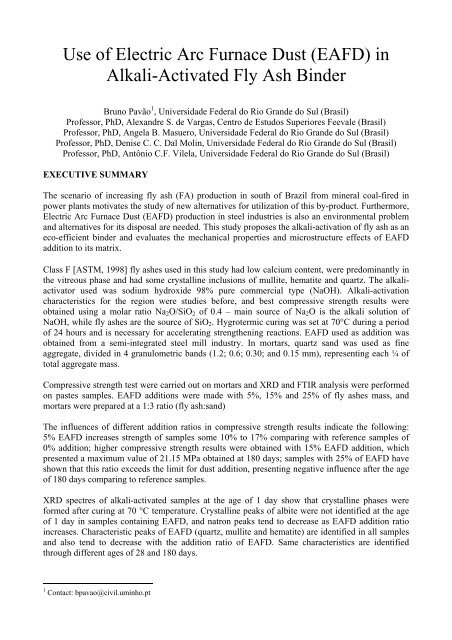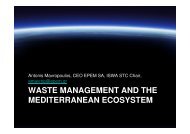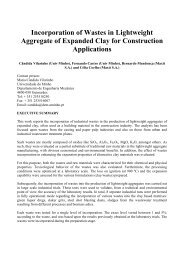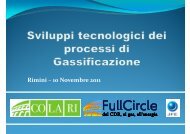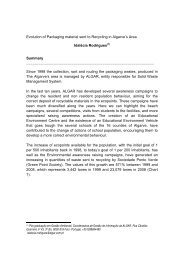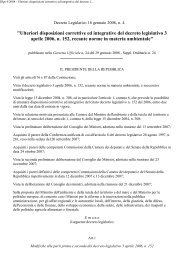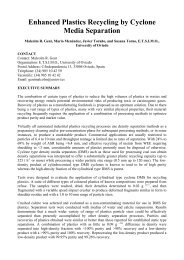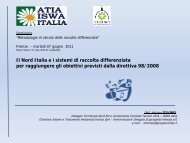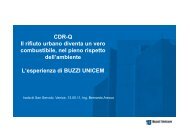Use of Electric Arc Furnace Dust (EAFD) in Alkali-Activated ... - ISWA
Use of Electric Arc Furnace Dust (EAFD) in Alkali-Activated ... - ISWA
Use of Electric Arc Furnace Dust (EAFD) in Alkali-Activated ... - ISWA
- No tags were found...
You also want an ePaper? Increase the reach of your titles
YUMPU automatically turns print PDFs into web optimized ePapers that Google loves.
<strong>Use</strong> <strong>of</strong> <strong>Electric</strong> <strong>Arc</strong> <strong>Furnace</strong> <strong>Dust</strong> (<strong>EAFD</strong>) <strong>in</strong><strong>Alkali</strong>-<strong>Activated</strong> Fly Ash B<strong>in</strong>derBruno Pavão 1 , Universidade Federal do Rio Grande do Sul (Brasil)Pr<strong>of</strong>essor, PhD, Alexandre S. de Vargas, Centro de Estudos Superiores Feevale (Brasil)Pr<strong>of</strong>essor, PhD, Angela B. Masuero, Universidade Federal do Rio Grande do Sul (Brasil)Pr<strong>of</strong>essor, PhD, Denise C. C. Dal Mol<strong>in</strong>, Universidade Federal do Rio Grande do Sul (Brasil)Pr<strong>of</strong>essor, PhD, Antônio C.F. Vilela, Universidade Federal do Rio Grande do Sul (Brasil)EXECUTIVE SUMMARYThe scenario <strong>of</strong> <strong>in</strong>creas<strong>in</strong>g fly ash (FA) production <strong>in</strong> south <strong>of</strong> Brazil from m<strong>in</strong>eral coal-fired <strong>in</strong>power plants motivates the study <strong>of</strong> new alternatives for utilization <strong>of</strong> this by-product. Furthermore,<strong>Electric</strong> <strong>Arc</strong> <strong>Furnace</strong> <strong>Dust</strong> (<strong>EAFD</strong>) production <strong>in</strong> steel <strong>in</strong>dustries is also an environmental problemand alternatives for its disposal are needed. This study proposes the alkali-activation <strong>of</strong> fly ash as aneco-efficient b<strong>in</strong>der and evaluates the mechanical properties and microstructure effects <strong>of</strong> <strong>EAFD</strong>addition to its matrix.Class F ASTM, 1998 fly ashes used <strong>in</strong> this study had low calcium content, were predom<strong>in</strong>antly <strong>in</strong>the vitreous phase and had some crystall<strong>in</strong>e <strong>in</strong>clusions <strong>of</strong> mullite, hematite and quartz. The alkaliactivatorused was sodium hydroxide 98% pure commercial type (NaOH). <strong>Alkali</strong>-activationcharacteristics for the region were studies before, and best compressive strength results wereobta<strong>in</strong>ed us<strong>in</strong>g a molar ratio Na 2 O/SiO 2 <strong>of</strong> 0.4 – ma<strong>in</strong> source <strong>of</strong> Na 2 O is the alkali solution <strong>of</strong>NaOH, while fly ashes are the source <strong>of</strong> SiO 2 . Hygrotermic cur<strong>in</strong>g was set at 70°C dur<strong>in</strong>g a period<strong>of</strong> 24 hours and is necessary for accelerat<strong>in</strong>g strengthen<strong>in</strong>g reactions. <strong>EAFD</strong> used as addition wasobta<strong>in</strong>ed from a semi-<strong>in</strong>tegrated steel mill <strong>in</strong>dustry. In mortars, quartz sand was used as f<strong>in</strong>eaggregate, divided <strong>in</strong> 4 granulometric bands (1.2; 0.6; 0.30; and 0.15 mm), represent<strong>in</strong>g each ¼ <strong>of</strong>total aggregate mass.Compressive strength test were carried out on mortars and XRD and FTIR analysis were performedon pastes samples. <strong>EAFD</strong> additions were made with 5%, 15% and 25% <strong>of</strong> fly ashes mass, andmortars were prepared at a 1:3 ratio (fly ash:sand)The <strong>in</strong>fluences <strong>of</strong> different addition ratios <strong>in</strong> compressive strength results <strong>in</strong>dicate the follow<strong>in</strong>g:5% <strong>EAFD</strong> <strong>in</strong>creases strength <strong>of</strong> samples some 10% to 17% compar<strong>in</strong>g with reference samples <strong>of</strong>0% addition; higher compressive strength results were obta<strong>in</strong>ed with 15% <strong>EAFD</strong> addition, whichpresented a maximum value <strong>of</strong> 21.15 MPa obta<strong>in</strong>ed at 180 days; samples with 25% <strong>of</strong> <strong>EAFD</strong> haveshown that this ratio exceeds the limit for dust addition, present<strong>in</strong>g negative <strong>in</strong>fluence after the age<strong>of</strong> 180 days compar<strong>in</strong>g to reference samples.XRD spectres <strong>of</strong> alkali-activated samples at the age <strong>of</strong> 1 day show that crystall<strong>in</strong>e phases wereformed after cur<strong>in</strong>g at 70 °C temperature. Crystall<strong>in</strong>e peaks <strong>of</strong> albite were not identified at the age<strong>of</strong> 1 day <strong>in</strong> samples conta<strong>in</strong><strong>in</strong>g <strong>EAFD</strong>, and natron peaks tend to decrease as <strong>EAFD</strong> addition ratio<strong>in</strong>creases. Characteristic peaks <strong>of</strong> <strong>EAFD</strong> (quartz, mullite and hematite) are identified <strong>in</strong> all samplesand also tend to decrease with the addition ratio <strong>of</strong> <strong>EAFD</strong>. Same characteristics are identifiedthrough different ages <strong>of</strong> 28 and 180 days.1 Contact: bpavao@civil.um<strong>in</strong>ho.pt
FTIR analysis shows that the process <strong>of</strong> alkali-activation is successful <strong>in</strong> all samples, regard<strong>in</strong>g thecharacteristic differences with the fly ash <strong>in</strong> its orig<strong>in</strong>al state. Fly ash band at 1084 cm -1 shifts toaround 1000 cm -1 <strong>in</strong> samples with <strong>EAFD</strong> addition, demonstrat<strong>in</strong>g no <strong>in</strong>terference <strong>in</strong> polymerizationand formation <strong>of</strong> alum<strong>in</strong>osilicate gel. No wavelength difference was found between reference and<strong>EAFD</strong> added samples through different ages.Results demonstrate potentiality <strong>of</strong> b<strong>in</strong>der proposed, especially for precast concrete production.Low carbon emission to atmosphere, susta<strong>in</strong>able characteristics, reduced energy demand and theuse <strong>of</strong> wastes and by-products are valuable positive aspects. Microstructural XRD analysis suggeststhe occurrence <strong>of</strong> reactions with the crystall<strong>in</strong>e <strong>EAFD</strong> material. FTIR analysis <strong>in</strong>dicates that theadditions have no <strong>in</strong>terference <strong>in</strong> polymerization and alum<strong>in</strong>ossilicate gel formation.INTRODUCTIONPortland cement, a material <strong>of</strong> choice for over the last centuries, praised for its mechanicalperformance, competitive price, and versatility, is also an issue <strong>of</strong> concern for its environmentalimpact. Resource and energy consumption and carbon dioxide emission are problems faced bycement <strong>in</strong>dustry. Production and study <strong>of</strong> environmental friendly b<strong>in</strong>ders are therefore needed, andalternative materials are listed as choice options for tackl<strong>in</strong>g the problem.<strong>Alkali</strong>-activated b<strong>in</strong>ders have been objective <strong>of</strong> several studies over the last half century(PACHECO-TORGAL et al., 2008) and are matter <strong>of</strong> <strong>in</strong>terest <strong>in</strong> scientific communities for its ecoefficientproperties and the possibility <strong>of</strong> use <strong>of</strong> different types <strong>of</strong> <strong>in</strong>dustries by-products and wastesas source material, some <strong>of</strong> them already <strong>in</strong> use as additions to Portland cement (BUSCHWALDand SCHULZ, 2005). <strong>Alkali</strong>-activation briefly consists <strong>of</strong> submitt<strong>in</strong>g a source material withalum<strong>in</strong>ates and silicates <strong>in</strong>to an alkali aggressive environment <strong>in</strong> such way that the former exist<strong>in</strong>gbonds change structure <strong>in</strong>to an alunimossilicate gel that provides mechanical strength. Theseb<strong>in</strong>ders are produced by mix<strong>in</strong>g amorphous materials rich <strong>in</strong> SiO 2 and Al 2 O 3 and submitt<strong>in</strong>g them toa strong alkal<strong>in</strong>e medium, us<strong>in</strong>g activators such as NaOH, KOH and Na2SiO4. The alkal<strong>in</strong>emedium breaks the covalent bonds Si – O – Si – and Al – O – Al <strong>of</strong> the precursor material andpromotes the polycondensation <strong>of</strong> the Si – O – Al type <strong>in</strong>to polymeric cha<strong>in</strong>s, form<strong>in</strong>g sodiumalum<strong>in</strong>osilicate gel, which is responsible for the durability properties <strong>of</strong> this material (PALOMO etal., 1999). One such possible alternative is cement obta<strong>in</strong>ed from alkali-activated fly ashes (FA), asproposed for the materials <strong>in</strong> the south <strong>of</strong> Brazil <strong>in</strong> this and <strong>in</strong> previous work (VARGAS, 2006).The scenario <strong>in</strong> south <strong>of</strong> Brazil stimulates research<strong>in</strong>g alternative uses for thermoelectric byproducts:the region possesses about 89% <strong>of</strong> the m<strong>in</strong>eral coal reserves <strong>in</strong> the country, a total <strong>of</strong>about 28.8 billion tons. Nevertheless, these resources present a low calorific coefficient <strong>of</strong> 2600 to3200 kcal/kg and a high level <strong>of</strong> fly ashes production – 1 kg <strong>of</strong> fired coal generates approximately 1kWh and 400 g <strong>of</strong> fly ashes. Currently, coal-fired electrical power plants generate about 2 milliontons <strong>of</strong> fly ashes <strong>in</strong> the region each year. Of this total, 20% to 30% is used by cement and concrete<strong>in</strong>dustries <strong>in</strong> the region, and the rest is disposed <strong>in</strong>to coal strip m<strong>in</strong><strong>in</strong>g trenches, which may causeextensive environmental damage, such as air, soil and groundwater contam<strong>in</strong>ation. Consider<strong>in</strong>g theprojects <strong>of</strong> new thermoelectric power plants, coal extraction <strong>in</strong> the region is predicted to <strong>in</strong>creasefrom 1.6 to 4.2 million tons per year (ROHDE, 2006; VARGAS, 2006)Produced <strong>in</strong> steel mills, electric arc furnace dust (<strong>EAFD</strong>) is classified as a hazardous waste, notdisposable <strong>in</strong> the environment, accord<strong>in</strong>g to the Resource Conservation and Recovery Act <strong>of</strong> theU.S. Environmental Protection Agency (UNITED STATES OF AMERICA, 2008). Its generalcomposition conta<strong>in</strong>s heavy metals such as Lead (Pb), Chromium (Cr) and Cadmium (Cd).
Techniques proposed for recycl<strong>in</strong>g these metals are still expensivee <strong>in</strong> the region, and further studiess<strong>of</strong> processes for immobiliz<strong>in</strong>g thematerial are still needed.Several alternative matrices were proposedfor immobiliz<strong>in</strong>g toxic waste. Palomo and Palacios(2002) evaluated the stabilisation/solidification capacity<strong>of</strong> alkali-activated flyash cement<strong>in</strong>g matrix<strong>in</strong> the presence <strong>of</strong> toxic elements, and leach<strong>in</strong>g tests carried out <strong>in</strong>dicated that this new b<strong>in</strong>der wasable to stabilise and solidify lead <strong>in</strong> a veryefficient way. Deja (2002) studied the properties <strong>of</strong>alkali-activated slag pastes <strong>in</strong> the presence <strong>of</strong> Z<strong>in</strong>c (Zn), Cd, Crand Pb ions and found that thedegree <strong>of</strong> immobilization was very high (exceed<strong>in</strong>g 99.9%). Shi and Fernanández-Jiménez (2006),review<strong>in</strong>g the progresses <strong>in</strong> use <strong>of</strong> alkali-activatedb<strong>in</strong>ders for stabilization/solidification <strong>of</strong>hazardous and radioactive wastes, concluded that the leachability<strong>of</strong> contam<strong>in</strong>ants <strong>in</strong> these b<strong>in</strong>dersis lower than that from hardened Portlandcement stabilized wastes. Palomo and Fuente (2002)show that boron does not significantly alter the harden<strong>in</strong>g processs <strong>of</strong> alkali-activated flyashes, thattits presence hardly modifies mechanical strength and, tak<strong>in</strong>g leach<strong>in</strong>g resultss <strong>in</strong>to account, that thealternative system was more effective thantraditionalones. Vargas (2002) studied theeffects <strong>of</strong><strong>EAFD</strong> additions <strong>in</strong> Portland cement concrete blocks and, although some heavy metals wereeimmobilized, the sett<strong>in</strong>g time <strong>of</strong> the b<strong>in</strong>der was severelyaltered bythe presence <strong>of</strong> z<strong>in</strong>c.The purpose <strong>of</strong> this study was toevaluate the effects <strong>of</strong> three <strong>EAFD</strong> addition ratios to a previousstudied b<strong>in</strong>der made <strong>of</strong> alkali-activated fly ashes (VARGAS,2006). Mechanical <strong>in</strong>fluence <strong>of</strong>additions was determ<strong>in</strong>ed <strong>in</strong> compressivestrength tests and microstructurecharacterization wasmade us<strong>in</strong>gXRD analysis and FTIR wavelength comparisons.EXPERIMENTALMaterialsClass F (ASTM, 1998) fly ash generated bya coal-firedpower plant located <strong>in</strong> southernBrazil wasused <strong>in</strong> this study. Ashes had low calcium content, were predom<strong>in</strong>antly <strong>in</strong> the vitreousphase andhad some crystall<strong>in</strong>e <strong>in</strong>clusions <strong>of</strong> mullite, hematite and quartz. XRD spectraconta<strong>in</strong><strong>in</strong>gcrystall<strong>in</strong>epeaks are shown <strong>in</strong> Figure 1 and physical and chemical characterization <strong>of</strong> flyash <strong>in</strong> Table 1.Figure 1: XRD spectra <strong>of</strong> fly ash; Q = Quartz; M = Mullite; H = HematiteThe alkali-activator used was sodium hydroxide 98%pure commercial type (NaOH)with 2.13g/cm³ <strong>of</strong> density.Table 1: Chemical composition<strong>of</strong> fly ash (%<strong>of</strong> mass)I.R. a L.O.I bSiO 2 Al 2 2O 3 CaO Fe 2 O 3 Na 2 O TiO 2 MgO K 2 O SO 4(%) (%)63.09 24. 02 1.15 6.85 0.211.77 0. 81 1.75 0.34 97.0aI.R. <strong>in</strong>solubleresidue.0.02Specific density c(g/cm 3 )2.17
L. .O.I. loss onignition.c NBR NM 23 (ABNT, 2000).<strong>EAFD</strong> used as addition was obta<strong>in</strong>ed from a semi-<strong>in</strong>tegrated steel mill <strong>in</strong>dustry, collected by filtersoutside theelectric arch oven. Chemical composition <strong>of</strong> the material <strong>in</strong>dicates majority <strong>of</strong> Iron andZ<strong>in</strong>c, accord<strong>in</strong>g to Table 2. XRD spectra<strong>of</strong> <strong>EAFD</strong> present crystall<strong>in</strong>e peaks <strong>of</strong> quartz (SiO 2 ),hematite ( Fe 2 O 3 ), frankl<strong>in</strong>ite (Fe 2 O 3 ZnO), z<strong>in</strong>cite (ZnO) and cromite (FeO.Cr 2 O 3 ), asshown <strong>in</strong>Figure 2.Table 2: Chemical composition<strong>of</strong> <strong>EAFD</strong> (%<strong>of</strong> mass)Na K Fe Mg CaPb Si Mn CdCr Zn3.35 1.0827.30 1.87 2.540.90 1.70 2.06 0.37 0. 13 37.25Figure 2: XRD spectra <strong>of</strong> <strong>EAFD</strong>In mortars,quartz river sand wasused as f<strong>in</strong>e aggregate, divided <strong>in</strong>4 granulometric bands (1.2; 0.6;0.30; and 0.15 mm), represent<strong>in</strong>geach ¼ <strong>of</strong> total aggregate mass.Analysis <strong>of</strong> metal concentration<strong>in</strong> leach<strong>in</strong>gsamples, obta<strong>in</strong>ed accord<strong>in</strong>g to a Brazilianproceduree(ABNT, 2004b), is presented <strong>in</strong> Table 3. Results <strong>of</strong> Cdand Pb concentrations are above the <strong>in</strong>dexlimit (ABNT, 2004a),thus classify<strong>in</strong>g <strong>EAFD</strong> as “Class I” hazardous waste - not disposable <strong>in</strong> theenvironment.TablElementConcentration (mg/l)Limit (ABNT, 2004a)nd: not def<strong>in</strong>eddle 3: <strong>EAFD</strong>Zn913ndD leach<strong>in</strong>g teNa565ndest results (mCdmg/l)Cr6.9 0.0020.5 5Pb Cr+661 < 0.011 ndMethodsExperimental work was made to verify the <strong>in</strong>fluence <strong>of</strong> <strong>EAFD</strong> additions to alkali-activated fly ashmortar samples, evaluat<strong>in</strong>g compressive strength. Paste samples were submitted to XRD analysissand FTIR spectroscopy for wavelength comparisons.<strong>Alkali</strong>-activation characteristicsfor the region were studied before (VARGAS, 2006), and bestcompressive strength results were obta<strong>in</strong>ed us<strong>in</strong>g a molar ratio Na2 O/SiO 2 (N/S) <strong>of</strong> 0.4 – <strong>in</strong> whichhthe ma<strong>in</strong> source <strong>of</strong> Na 2 O is the alkali solution <strong>of</strong> NaOH, while fly ashes are the source <strong>of</strong> SiO 2 .Hygrotermic cur<strong>in</strong>g was set at70°C dur<strong>in</strong>g a period <strong>of</strong> 24 hours necessary for accelerat<strong>in</strong>gstrengthen<strong>in</strong>g reactions.
(a)(b)Figure 3: (a) Compressivee strength (MPa); (b) Strength ga<strong>in</strong>(%)Microstructural AnalysisXRDXRD spectres <strong>of</strong> alkali-activatedsamples at the age <strong>of</strong> 1 day (Figure 2) show that crystall<strong>in</strong>e phasesswere formed after cur<strong>in</strong>g at 70 °Ctemperature. Crystall<strong>in</strong>e peaks <strong>of</strong> albite were not identified at theage <strong>of</strong> 1 day <strong>in</strong> samples conta<strong>in</strong><strong>in</strong>g <strong>EAFD</strong>,and natronn peaks tend to decrease as <strong>EAFD</strong> additionratio <strong>in</strong>creases. Characteristic peaks <strong>of</strong> <strong>EAFD</strong> (quartz, mullite and hematite) are identified <strong>in</strong> alllsamples and also tend to decrease with the addition ratio <strong>of</strong> <strong>EAFD</strong>. Same characteristics wereeobserved at the age <strong>of</strong>180 days ( Figure 3).Figure 4: XRD spectres <strong>of</strong>: (a) <strong>EAFD</strong>; (b) FA; and paste samples at age <strong>of</strong>1 day with: (c) 0%<strong>EAFD</strong>; (d)5% <strong>EAFD</strong>; (e) 15% <strong>EAFD</strong>; and 25% <strong>EAFD</strong>
Figure 5: XRD spectres <strong>of</strong>: (a) <strong>EAFD</strong>; (b)FA; and paste samples at age <strong>of</strong> 180 day with: (c) 0%<strong>EAFD</strong>; (d) 15%<strong>EAFD</strong>; and(e) 25% <strong>EAFD</strong>Observation <strong>of</strong> XRDpeaks <strong>of</strong>samples with 25% <strong>EAFD</strong> through time (Figure 6) shows n<strong>of</strong>ormation <strong>of</strong> albite. Natron peaks, present <strong>in</strong>early age <strong>of</strong> 1 day, dim<strong>in</strong>ishes at the age <strong>of</strong> 180 days,suggest<strong>in</strong>gg that the carbonate maybe comb<strong>in</strong><strong>in</strong>g with other elements <strong>in</strong> the matrix.Figure 6:XRD spectres <strong>of</strong>: (a) <strong>EAFD</strong>; (b) FA; and paste sampless with N/S 0.4 and 25%<strong>EAFD</strong> attheages <strong>of</strong>: (c) 1day; (d) 28 days; (e)91 days and (f) 180 daysFTIRConsider<strong>in</strong>g FA and alkali-activated samples, <strong>in</strong>dependently <strong>of</strong> age <strong>of</strong> analysis (Figure7 and 8),there are characteristic absorption bands common to fly ash before and after activation, namely3435, 1625, 796, 779, 693, 559 e 461 cm -1 . As observed <strong>in</strong> FTIRspectra <strong>of</strong> orig<strong>in</strong>al flyash bands(Figure 7, sample b) 3450 cm -1 e a 1650 cm-1 frequencies <strong>in</strong>dicatethe presence <strong>of</strong> water molecules,results that agree with previous studies (BARBOSAet al., 2000) that identified the presence <strong>of</strong>water <strong>in</strong> orig<strong>in</strong>al metakaol<strong>in</strong> and <strong>in</strong> metakaol<strong>in</strong> alkali-activated samples.Dur<strong>in</strong>g alkali-activation, bands near 3450 cm-1 and 1650 cm -1 are more <strong>in</strong>tense than orig<strong>in</strong>al fly ashbands, as observed <strong>in</strong> figures 7 and 8. Bandnear 3450 cm -1 is related to vibration and stretch<strong>in</strong>g <strong>of</strong>water molecules H-O-H, and band near 1650 cm -1 isrelated to angular deformations<strong>in</strong> H-O-HHbonds (PALOMO et al., 1999).
Figure7: FTIR Spectra <strong>of</strong>: ( a) <strong>EAFD</strong>; (b) FA; paste samples with 0% <strong>EAFD</strong> at: (c)1 day; (d)28 days; (e) 91 days; (f) 180days; paste samples with 15% <strong>EAFD</strong> at: (g) 1 day; (h) 28 days;(i) 91 days; (j) 180 daysFigure 8: FTIR Spectra <strong>of</strong>: (a) <strong>EAFD</strong>; (b) FA; paste samples with 180 days with: (c) 0%<strong>EAFD</strong> (d)5% <strong>EAFD</strong>; (e) 15% <strong>EAFD</strong>; and (f) 25%<strong>EAFD</strong>Absorptionbands near 796 cm -1 e a 693 cm-1 are related to the presence <strong>of</strong> alum<strong>in</strong>ium and quartz,respectively. Bakharev(2005) proposed thatt the band near 800 cm-1 is relatedto vibrations <strong>in</strong> AlO and that bands near 688 cm -1 4aredue to symmetrical stretch<strong>in</strong>g vibrations <strong>in</strong>Si-O-Si bonds <strong>in</strong> flyash samples.560 and 460 cm -1 bands were also identified <strong>in</strong> fly ashsamples before and after alkali-activation.Palomo et al. (1999) obta<strong>in</strong>ed similar resultss and proposed that band 560 cm -1 <strong>in</strong>dicates the presencee<strong>of</strong> mullite (octahedralformation) ). In XRD analysis these results are confirmed with the presence <strong>of</strong>crystall<strong>in</strong>e peaks <strong>of</strong> mullite <strong>in</strong> figures 4, 5 and 6.Characteristic bands cited above (796, 779, 693, 559 e 461 cm -1 ) were identified both <strong>in</strong> orig<strong>in</strong>al flyash and <strong>in</strong> alkali-activated fly ashsamples (Figures 7 and 8). As these bands are related to Si-O-Si eSi-O-Al bonds, FTIRresults confirm XRDanalysis, thus demonstrat<strong>in</strong>g thechemical stability <strong>of</strong>crystall<strong>in</strong>e quartz and mullite <strong>in</strong> a strong alkali environment.Band 10900 cm -1 fromorig<strong>in</strong>al fly ash is altered to regions near to 1000 cm-1 <strong>in</strong> alkali activatedsamples. This is proposed to be related with vibrations <strong>in</strong> Si-O and Al-O bonds, and reduc<strong>in</strong>g thefrequency <strong>in</strong> this region suggests that vitreous components <strong>of</strong> flyash are react<strong>in</strong>g withthe alkali-activator and that different products arebe<strong>in</strong>g formed – namely the alum<strong>in</strong>ossilicate gel(FERNÁNDEZ-JIMENEZ et al., 2005).Comparisons <strong>of</strong> alkali-activatedfly ash samples andsamples with <strong>EAFD</strong>additions show nodifference <strong>in</strong> frequencies <strong>of</strong> bands <strong>in</strong> FTIR analysis. These results <strong>in</strong>dicate that alkali-activation issuccessful <strong>in</strong> all samples and that <strong>EAFD</strong> additions haveno harmful <strong>in</strong>terference <strong>in</strong> the formation <strong>of</strong>alum<strong>in</strong>osilicate gel and the <strong>in</strong> thepolymerization reactions.CONCLUSIONS
Results demonstrate potentiality <strong>of</strong> b<strong>in</strong>der proposed here, especially for precast concrete production.Low carbon emission to atmosphere, susta<strong>in</strong>able characteristics, reduced energetic demand and theuse <strong>of</strong> wastes and by-products are valuable positive aspects for society and scientific communities.Mechanical properties <strong>of</strong> this b<strong>in</strong>der can be improved us<strong>in</strong>g fly ash conta<strong>in</strong><strong>in</strong>g a higher level <strong>of</strong> SiO 2and us<strong>in</strong>g processes for reduc<strong>in</strong>g the fly ash mean particle size. Microstructural XRD analysissuggests that albite, natron and characteristic <strong>EAFD</strong> crystall<strong>in</strong>e peaks decrease <strong>in</strong>tensity accord<strong>in</strong>gto <strong>EAFD</strong> addition ratio, <strong>in</strong>dicat<strong>in</strong>g the occurrence <strong>of</strong> reactions with the crystall<strong>in</strong>e material. FTIRanalysis <strong>in</strong>dicates that orig<strong>in</strong>al fly ash is successfully alkali-activated and that no significantdifference is found among the <strong>EAFD</strong> addition ratios, prov<strong>in</strong>g that the additions have no <strong>in</strong>terference<strong>in</strong> polymerization and alum<strong>in</strong>ossilicate gel formation.REFERENCESASSOCIAÇÃO BRASILEIRA DE NORMAS TÉCNICAS, ABNT (1996): NBR 7215: cimentoPortland – determ<strong>in</strong>ação da resistência à compressão. Rio de Janeiro, 1996 (<strong>in</strong> Portuguese).ASSOCIAÇÃO BRASILEIRA DE NORMAS TÉCNICAS, ABNT (2000): NBR MN 23: cimentoPortland e outros materiais em pó – determ<strong>in</strong>ação da massa específica. Rio de Janeiro, 2000 (<strong>in</strong>Portuguese).ASSOCIAÇÃO BRASILEIRA DE NORMAS TÉCNICAS, ABNT (2003): NM 43: cimentoPortland – determ<strong>in</strong>ação da pasta de consistência normal. Rio de Janeiro, 2003 (<strong>in</strong> Portuguese).ASSOCIAÇÃO BRASILEIRA DE NORMAS TÉCNICAS, ABNT (2004a). NBR 10004: resíduossólidos - classificação. Rio de Janeiro, 2004a. (<strong>in</strong> Portuguese).ASSOCIAÇÃO BRASILEIRA DE NORMAS TÉCNICAS, ABNT (2004b). NBR 10005:Procedimento para obtenção do extrato lixiviado de resíduos sólidos. Rio de Janeiro, 2004b. (<strong>in</strong>Portuguese).AMERICAN SOCIETY FOR TESTING AND MATERIALS, ASTM (1998). “StandardSpecification for Coal Fly abd Raw or Calc<strong>in</strong>ed Orig<strong>in</strong>al Pozzolan for <strong>Use</strong> as a M<strong>in</strong>eral Admixture<strong>in</strong> Concrete”. ASTM C618/98. In: Annual Book <strong>of</strong> ASTM, V. 04.02, Philadelphia, 1998.Bakharev, T. (2005): Geopolymeric materials prepared us<strong>in</strong>g Class F fly ash elevated temperaturecur<strong>in</strong>g. Cement and Concrete Research, v. 35, p. 1224-1232, 2005.Barbosa, V.; Mackenzie, K.; Thaumaturgo, C. (2000): Synthesis and Characterisation <strong>of</strong> MaterialsBased on Inorganic Polymers <strong>of</strong> Alum<strong>in</strong>a and Silica: Sodium Polysialate Polymers. InternationalJournal <strong>of</strong> Inorganic Materials, v. 2, p. 309-317, 2000.Buschwald, A.; Schultz M. (2005): <strong>Alkali</strong>-activated b<strong>in</strong>ders by use <strong>of</strong> <strong>in</strong>dustrial by-products.Cement and Concrete Research 35, pp.968–973.Deja J., (2002): Immobilization <strong>of</strong> Cr 6+ , Cd 2+ , Zn 2+ and Pb 2+ <strong>in</strong> alkali-activated slag b<strong>in</strong>ders.Cement and Concrete Research, 32 (2002), pp. 1971–1979.Fernández-Jiménez, A.; Palomo, A.; Criado, M. (2005): Composition and microstructure <strong>of</strong> alkaliactivated fly ash b<strong>in</strong>der: effect <strong>of</strong> the activator. Cement and Concrete Research. Volume 35, Issue 6,p. 1204-1209, 2005.
Pacheco-Torgal, F.; Castro-Gomes, J.; Jalali, S. (2008): <strong>Alkali</strong>-activated b<strong>in</strong>ders: A review. Part 1.Historical background, term<strong>in</strong>ology, reaction mechanisms and hydration products. Constructionand Build<strong>in</strong>g Materials 22, pp. 1305–1314.Palomo A., Palacios M. (2002): <strong>Alkali</strong>-activated cementitious materials: Alternative matrices forthe immobilisation <strong>of</strong> hazardous wastes - Part II. Stabilisation <strong>of</strong> chromium and lead. Cement andConcrete Research, 33(03), pp. 289–295.Palomo, A.; Fuente, J. I. L. (2003): <strong>Alkali</strong>-activated cementitous materials: Alternative matrices forthe immobilisation <strong>of</strong> hazardous wastes: Part I. Stabilisation <strong>of</strong> boron. Cement and ConcreteResearch 33 (2), Feb. 2003, pp. 281-288Palomo, A.; Grutzeck, M.; Blanco, M. (1999): <strong>Alkali</strong>-acivated Fly Ashes. A Cement for Future.Cement and Concrete Research, v. 29, p. 1323-1329, 1999.Rohde, G.M. (2006): C<strong>in</strong>zas de carvão no Brasil: Restrições ambientais e medidas mitigadoras. In:Rohde GM. et al. C<strong>in</strong>zas de Carvão Fóssil no Brasil – Aspectos Técnicos e Ambientais, PortoAlegre: CIENTEC, 2006. Chap. 2: 137-195 (<strong>in</strong> Portuguese).Shi, C.; Fernández-Jiménez, A. (2006): Stabilization/solidification <strong>of</strong> hazardous and radioactivewastes with alkali-activated cements. Journal <strong>of</strong> Hazardous Materials 137 (3), 11 October 2006, pp.1656-1663.United States <strong>of</strong> America, (2008): Environmental Protection Agency. RCRA Orientation Manual2008: Resource Conservation and Recovery Act (2008).http://www.epa.gov/osw/<strong>in</strong>foresources/pubs/orientat/rom.pdf (Jun. 02, 2009).Vargas, A. (2002). Estudo da viabilidade do uso do pó de aciaria elétrica na confecção de blocosde concreto para pavimentação. 2002. 148 f. Dissertação (Mestrado em Engenharia) - Programa dePós-Graduação em Engenharia Civil, Universidade Federal do Rio Grande do Sul, Porto Alegre (<strong>in</strong>Portuguese).Vargas, A. (2006): C<strong>in</strong>zas volantes álcali-ativadas para a obtenção de aglomerantes especiais.2006. 154 f. Tese (Doutorado em Engenharia) – Programa de Pós-Graduação em Engenharia Civil.Universidade Federal do Rio Grande do Sul, Porto Alegre, 2007 (<strong>in</strong> Portuguese).


